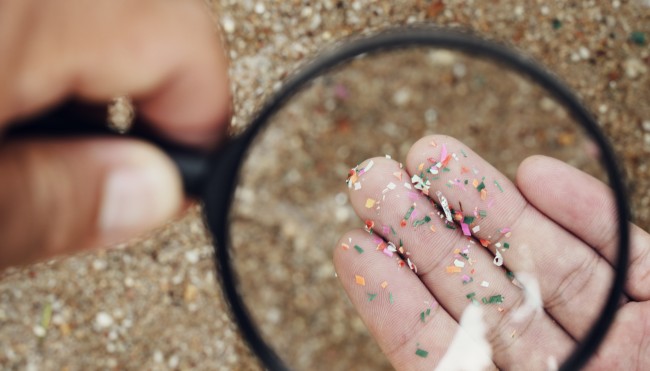What is Acrylates/C10-30 Alkyl Acrylate Crosspolymer?
Countries such as the United Kingdom, the United States of America, Canada or New Zealand have already banned the use of microbeads in rinse-off cosmetics such as exfoliating scrubs, shower gels, make-up etc. But the use of other non-degradable synthetic polymers such as “Acrylates/C10-30 Alkyl Acrylate Crosspolymer” is still permitted. Those polymers are widely used in sun protection creams, shampoos and hairstyling products. Our Head of Science and ingredient expert Dr. Ruta Almedom explains what this compound is all about and why we classify it as ‘concerning’.
“Acrylates/C10-30 Alkyl Acrylate Crosspolymer” is a synthetically produced acrylate-based compound in which monomers are linked to synthetic groups and crosslinked to one another. The properties of the ingredients depend strongly on the linked residues. An important common feature of the cross-linked acrylate-based polymers is their poor biodegradability. In contrast to the solid microbeads, they can exist in soluble, liquid, gel or waxy forms. Based on those features “Acrylates/C10-30 Alkyl Acrylate Crosspolymer” is not classified as microbeads but as persistent, synthetic polymer.
What are microbeads?
The term microbeads covers all solid and insoluble synthetic polymer particles which are smaller than five millimetres. In general, a distinction is made between primary and secondary microbeads. Secondary microbeads occur when larger plastic parts, such as plastic bags, disintegrate. Primary microbeads are produced industrially, usually in the form of fine plastic granules or particles. Microscopically small plastic particles can be found in various cosmetics, including peelings, shower gels, lipsticks, make-up and other cosmetics. Since January 2018 the use of microbeads in rinse-off products has been banned in the United Kingdom.
The difference between rinse-off and leave-on
With banning microbeads in rinse-off products across the UK, the problem is just halfway solved. The use of microbeads in cosmetic leave-on products is still allowed. Those products are not intended to be removed with water according to usage instructions and include decorative cosmetics such as lipstick, mascara and other makeup products. However, it is widely known that consumers deviate from the intended use and still wash off their make-up which accesses waste water. Subsequently - those microbeads still end up in our environment, despite of the plastic microbead ban. There is strong need to extend the focus area and also discuss implications of microbeads in leave-on products which likely end up in open water.
There are more non-biodegradable polymers beyond microbeads
Furthermore we need to broaden the scope beyond solid plastic particles, such as “polyethylene”, “polypropylene” or “polyethylene terephthalate” and include soluble, liquid, gel-forming or waxy synthetic polymers. Some of the most commonly used are...
- “Acrylates/C10-30 Alkyl Acrylate Crosspolymer”,
- “Acrylates Copolymer”
- “Styrene Acrylates Copolymer”
- “Polyquaternium-7”
- ...and many more poorly biodegradable synthetic polymers.
Why are persistent synthetic polymers similarly concerning?
Unlike microbeads, the soluble, liquid, gel-forming or waxy synthetic polymers, such as “Acrylates/C10-30 Alkyl Acrylate Crosspolymer”, have no peeling properties but rather serve as consistency enhancers, opacifiers or fillers. While microbeads and these other synthetic polymers have different physical properties and functions in cosmetic products, their impact on the environment is often similar.
It is unclear to what extent persistent, synthetic polymers such as “Acrylates/C10-30 Alkyl Acrylate Crosspolymer” is filtered out in sewage treatment plants. Similar to microbeads, they either reach the open water unfiltered or remain in the sewage sludge. Accordingly, various synthetic polymers which are difficult to decompose have already been found in the gills of fish. In addition, those highly charged polymers can form insoluble complexes with other compounds. When they enter our rivers and seas, they can form larger clusters with pollutants present in the water. To date, long-term environmental effects of such toxic and non-degradable clusters remain unknown. The high complexity of the polymer structures and properties makes is difficult for research groups to conduct in-depth analyses and fully understand their impact on environment and health.
Furthermore, in Germany and UK, sewage sludge enriched with microbeads and other non-biodegradable synthetic polymers is used on agriculture and ends up end up on our fields - and may find its way into fruits, vegetables and cereals. According to a new study by the WWF we are ingesting an average of 5 grams of plastic every week, the equivalent of a credit card. The long-term consequences are still unknown.
A matter of definiton?
Addressing this topic properly requires a common ground to initiate discussions and enable new regulations. However, the lack of a general definition leads to differing assessments by environmental organisations and manufacturers. Many companies have focused on removing particulate microbeads, such as polyethylene, from their rinse-off products. But which substances are covered under the term microbead? According to Greenpeace, the term microbeads covers all plastics, especially durable, toxic and/or bioaccumulating plastics and synthetic polymers. Friends of the Earth Germany (BUND) states that "Plastics are used in a large number of cosmetic products, as abrasives, binders, fillers and film-forming agents in particulate form as microbeads but also in liquid form“.
One thing is for sure, many soluble, liquid, gel-forming and waxy synthetic polymers are persistent and potentially remain in the environment for hundreds of years. The discussion around microbeads should therefore be expanded to include other non-biodegradable synthetic polymers.
We are taking an important step with CodeCheck and broaden our criteria to include all synthetic polymers, such as solid microbeads and other non-solid synthetic polymers, and evaluate them based on their environmental impact.
Links to other websites:
- Sewage sludge in agriculture: code of practice for England, Wales and Northern Ireland, Department for Environment Food & Rural Affairs, 2018
- Evidence of microplastic accumulation in agricultural soils from sewage sludge disposal, Corradini.F et.al, 2019
- Investigating options for reducing releases in the aquatic environment of microplastics
- WWF Analysis on plastic
- Intentionally added microplastics in products, EU Commission, October 2017





